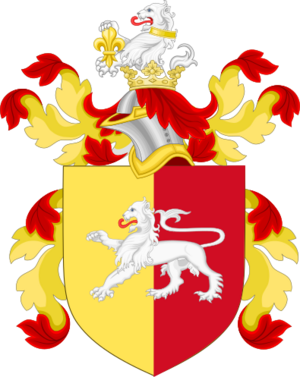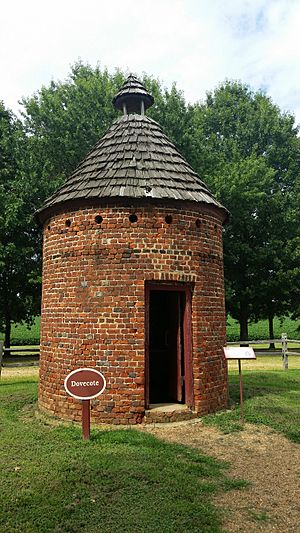Shirley Plantation facts for kids
|
Shirley
|
|

Main house of Shirley Plantation, July 2006
|
|
| Location | 5 mi. N of Hopewell off VA 608, Hopewell, Virginia |
|---|---|
| Built | circa 1723 |
| Architectural style | Georgian |
| NRHP reference No. | 69000328 |
Quick facts for kids Significant dates |
|
| Added to NRHP | October 1, 1969 |
| Designated NHL | April 15, 1970 |
Shirley Plantation is a historic estate located on the James River in Charles City County, Virginia. It sits along State Route 5, a scenic road between Richmond and Williamsburg. Shirley is known as the oldest active plantation in Virginia, with its beginnings in 1613. It is also the oldest family-owned business in North America, as the Hill family took ownership in 1638.
At first, people from Europe who agreed to work for a certain time, called indentured servants, were the main workers. Later, in the early 1700s, enslaved African people became the primary labor force. About 70 to 90 enslaved individuals worked there at any given time. They did many jobs, like plowing fields, cleaning, caring for children, and cooking.
Shirley Plantation was added to the National Register in 1969. It was then named a National Historic Landmark in 1970. Today, it is recognized as one of the oldest continuously operating businesses in the United States.
Contents
Exploring Shirley Plantation's Past
The land where Shirley Plantation stands was first settled by Europeans in 1613. Sir Thomas West, also known as the 3rd Baron De La Warr, claimed the area. He named it West and Sherley Hundred. This name likely honored his wife, Cessalye, whose father was Sir Thomas Sherley.
In 1616, John Rolfe wrote about Shirley as one of the first European settlements. He noted that Captain Isaac Maddeson led 25 workers there. These workers focused on growing and preparing tobacco. Tobacco was a very important crop that was sent to other colonies and England. Shirley Plantation survived a Native American uprising in 1622. For a while, it was the westernmost European settlement on the north side of the James River.
The Hill Family Takes Over
In 1638, Edward Hill bought part of this land. This marked the beginning of the Hill family's ownership. The Hill family is believed to be related to Sir Rowland Hill, who was known for publishing the Geneva Bible.
Edward Hill's original land was about 450 acres. Over time, through marriages and buying more land, the estate grew much larger. By 1660, Hill owned over 2,400 acres. After Edward Hill died, his son, Edward Hill II, took over. He owned the plantation during Bacon's Rebellion in 1676. During this time, rebels damaged the property.
Edward Hill II's son, Edward Hill III, inherited the property in 1700. He continued to run the plantation. However, Edward Hill III's only son died young. This meant the property would pass to one of his daughters. In 1726, Shirley Plantation went to his youngest daughter, Elizabeth. She had married John Carter in 1723.
Building the Great House
The construction of the main house, known as the "Great House," began around 1723. This grand mansion was finished in 1738. It was built near an older house, called the "Hill House," which was later taken down around 1868.
For nearly 300 years, at least eight generations of the Hill Carter family have lived in the Great House. Anne Hill Carter was born at Shirley. In 1793, she married Henry "Light Horse Harry" Lee in the mansion's parlor. They later became the parents of Confederate General Robert E. Lee.
Life and Labor at Shirley
From the mid-1600s, Shirley Plantation relied on enslaved people to grow cash crops, especially tobacco. After the American Revolutionary War, records from 1787 show that Charles Hill Carter owned 67 enslaved adults and 67 enslaved children at Shirley. He also owned many animals. In the 1800s, about 70 to 90 enslaved African people were forced to work on the plantation. They performed tasks like plowing fields, cleaning the house, and cooking meals.
After the American Civil War ended in 1865, enslaved people were freed. This meant that Hill Carter, who owned Shirley at the time, lost his forced labor force. In 1866, he divided his estate. The main part, which is today's Shirley Plantation, went to his son Robert. Another part, called 'Upper Shirley', went to his son William Fitzhugh Carter. Upper Shirley is now a vineyard.
Today, the upper floors of the Great House are still home to members of the Hill Carter family. The bottom floor is open for visitors to tour and learn about its history.
Shirley's Amazing Architecture
The "Great House" at Shirley is a three-story building built in the Georgian style. It has red brick walls and white trim. The house has a unique design because both the river side and the courtyard side look like main entrances. Each side has a two-story portico with Doric columns supporting a triangular roof section called a pediment.
Inside, the house has a famous carved walnut staircase. This "floating" or "flying" staircase rises three stories without any visible support. It is the only one of its kind in America. The roof is a hip roof style, meaning it slopes on all four sides. It has decorative moldings and two large brick chimneys. At the very top of the roof, there is a white pedestal with an upside-down pineapple on it. The pineapple is a symbol of welcome.
Around the main house, there are several other important buildings. These include a two-story kitchen with living spaces for enslaved Africans, a two-story laundry building, a smokehouse, a stable, an ice house, a large storehouse, and a dovecote (a small building for doves or pigeons). These buildings show how a large plantation operated in the past.
See also






